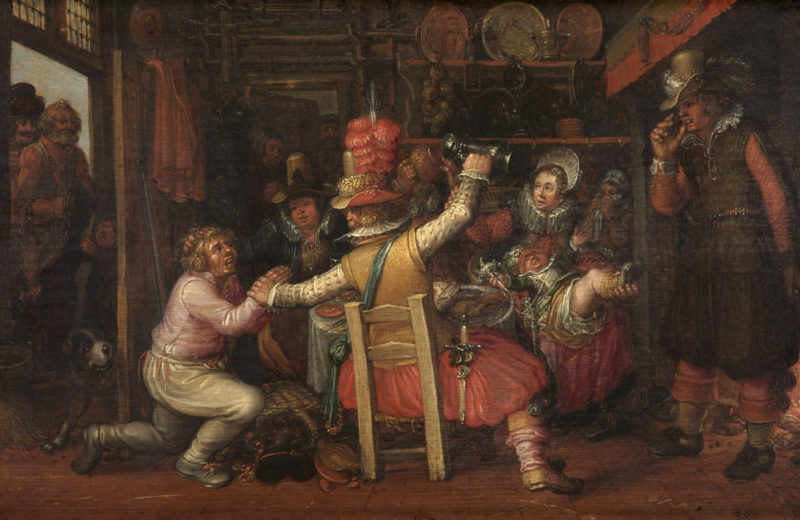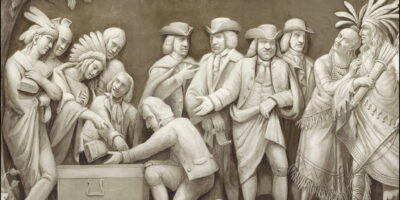Fact Checking the 1619 Project and Its Critics

The New York Times’ 1619 Project entered a new phase of historical assessment when the paper published a scathing criticism by five well-known historians of the American Revolution and Civil War eras. The group included previous critics James McPherson, Gordon Wood, Victoria Bynum, and James Oakes, along with a new signature from Sean Wilentz. The newspaper’s editor-in-chief Jake Silverstein then responded with a point-by-point rebuttal of the historians, defending the project.
Each deserve to be taken seriously, as they form part of a larger debate on the merits of the 1619 Project as a work of history and its intended use in the K-12 classroom curriculum. While the project itself spans some four centuries, devoting substantial attention to racial discrimination against African-Americans in the present day, the historians’ criticism focuses almost entirely on the two articles that are most directly pertinent to their own areas of expertise. The first is the lengthy introductory essay by Nikole Hannah-Jones, the Times journalist who edited the project. The second is a contentious essay on the relationship between slavery and American capitalism by Princeton University sociologist Matthew Desmond.
How should readers assess the competing claims of each group, seeing as they appear to be at bitter odds? That question is subject to a multitude of interpretive issues raised by the project’s stated political aims, as well as the historians’ own objectives as eminent figures – some might say gatekeepers – in the academic end of the profession.
But the debate may also be scored on its many disputed factual claims. To advance that discussion, I accordingly offer an assessment for each of the main points of contention as raised by the historians’ letter and Silverstein’s response.
1. Was the American Revolution fought in defense of slavery?
One of the most hotly contested claims of the 1619 Project appears in its introductory essay by Nikole Hannah-Jones, who writes “one of the primary reasons the colonists decided to declare their independence from Britain was because they wanted to protect the institution of slavery.”
Hannah-Jones cites this claim to two historical events. The first is the 1772 British legal case of Somerset v. Stewart, which reasoned from English common law that a slave taken by his owner from the colonies to Great Britain could not be legally held against his will. England had never established slavery by positive law, therefore Somerset was free to go.
The second event she enlists is a late 1775 proclamation by Lord Dunmore, the colonial governor of Virginia, in which he offered freedom to slaves who would take up arms for the loyalist cause against the stirring rebellion. The measure specified that it was “appertaining to Rebels” only, thereby exempting any slaves owned by loyalists.
Hannah-Jones argues that these two events revealed that British colonial rule presented an emerging threat to the continuation of slavery, thereby providing an impetus for slave-owning Americans to support independence. The American Revolution, she contends, was motivated in large part to “ensure slavery would continue.” The five historians vigorously dispute this claimed causality, indicating that it exaggerates the influence of these events vis-à-vis better known objects of colonial ire, as stated in the Declaration of Independence.
There is a kernel of truth in Hannah-Jones’s interpretation of these events. Somerset’s case is traditionally seen as the starting point of Britain’s own struggle for emancipation, and Dunmore’s proclamation certainly provoked the ire of slaveowners in the southern colonies – although they were more likely to interpret it as an attempt to foment the threat of a slave revolt as a counterrevolutionary strategy than a sign that Britain itself would impose emancipation in the near future.
Curiously unmentioned in the dispute is a much clearer case of how the loyalist cause aligned itself with emancipation, albeit in a limited sense. As part of his evacuation of New York City in 1783, British commander Sir Guy Carleton secured the removal of over 3,000 slaves for resettlement in Nova Scotia. This action liberated more than ten times as many slaves as Dunmore’s proclamation, the earlier measure having been offered as part of an increasingly desperate bid to retain power long after colonial opinion turned against him. Carleton’s removal also became a source of recurring tensions for U.S.-British relations after the war’s settlement. Alexander Hamilton, representing New York, even presented a resolution before the Confederation Congress demanding the return of this human “property” to their former owners.
That much noted, Hannah-Jones’s argument must be assessed against the broader context of British emancipation. It is here that the five historians gain the stronger case. First, despite both its high symbolic importance and later use as a case precedent, the Somerset ruling was only narrowly applied as a matter of law. It did not portend impending emancipation across the empire, nor did its reach extend to either the American colonies or their West Indian neighbors where a much larger plantation economy still thrived.
It is also entirely unrealistic to speculate that Britain would have imposed emancipation in the American colonies had the war for independence gone the other way. We know this because Britain’s own pathway to abolition in its remaining colonies entailed a half-century battle against intense parliamentary resistance after Somerset.
Simply securing a prohibition on the slave trade became a lifetime project of the abolitionist William Wilberforce, who proposed the notion in 1787, and of liberal Whig leader Charles James Fox, who brought it to a vote in 1791, only to see it go down in flames as merchant interests and West Indian planters organized to preserve the slave trade. Any student of the American Revolution will recognize the member of Parliament from Liverpool who successfully led the slave traders in opposition, for it was Banastre Tarleton, famed cavalry officer under General Cornwallis on the British side of the war.
Tarleton’s father and grandfather owned merchant firms in Liverpool, and directly profiteered from the slave trade. When Fox and Wilberforce’s slave trade ban came to a vote he led the opposition in debate. The measure failed with 163 against and only 88 in favor.
After more than a decade of failed attempts Fox eventually persevered, steering a bill that allowed the slave trade ban through the House of Commons as one of his final acts before he died in 1806. It would take another generation for Wilberforce and Thomas Clarkson, invested in a decades-long public campaign that highlighted the horrors of the institution and assisted by a large slave uprising in Jamaica, before a full Slavery Abolition Act would clear Parliament in 1833.
Nor was Tarleton the only loyalist from the revolutionary war with a stake in slavery as an institution. Lord Dunmore, whose 1775 proclamation forms the basis of the 1619 Project’s argument, comes across as a desperate political opportunist rather than a principled actor once he is examined in light of his later career. From 1787 to 1796 he served as colonial governor of the Bahamas, where he embarked on a massive and controversial building project to fortify the city of Nassau against irrational fears of foreign invasion. Dunmore used more than 600 enslaved laborers to construct a network of fortifications, including a famous 66-step staircase that they hand carved from solid rock under the threat of whipping and torture. Responding to a parliamentary inquiry on the condition of the colony’s slaves in 1789, Dunmore absurdly depicted them as well cared for and content with their condition.
Curiously enough, a British victory in the American Revolution would have almost certainly delayed the politics of this process even further. With the American colonies still intact, planters from Virginia, the Carolinas, and Georgia would have likely joined their West Indian counterparts to obstruct any measure that weakened slavery from advancing through Parliament. Subject to greater oversight from London, the northern colonies would have had fewer direct options to eliminate the institution on their own.
These state-initiated measures came about through both legislative action and legal proceeding, including a handful of “freedom cases” that successfully deployed reasoning similar to Somerset to strike against the presence of slavery in New England. The most notable example occurred in Massachusetts, where an escaped slave named Quock Walker successfully used the state’s new post-independence constitution of 1780 to challenge the legality of enforcing slavery within its borders.
Although they had significantly smaller slave populations than the southern states, several other northern states used the occasion of independence to move against the institution. The newly constituted state governments of Pennsylvania (1780), New Hampshire (1783), Connecticut (1784), Rhode Island (1784), and New York (1799) adopted measures for gradual but certain emancipation, usually phased in over a specified period of time or taking effect as underage enslaved persons reached legal majority. Vermont abolished slavery under its constitution as an independent republic aligned with the revolutionaries in 1777, and officially joined the United States as a free state in 1791. Antislavery delegates to the Confederation Congress were similarly able to secure a prohibition against the institution’s extension under the Northwest Ordinance of 1787, ensuring that the modern day states of Ohio, Michigan, Illinois, Wisconsin, and Indiana entered the Union as free states.
While these examples do not negate the pernicious effects of slavery upon the political trajectory of the former southern colonies, they do reveal clear instances where the cause of emancipation was aided – rather than impeded – by the American revolution. Britain’s own plodding course to emancipation similarly negates an underlying premise of Hannah-Jones’ depiction of the crown as an existential threat to American slavery itself in 1776. Indeed, the reluctance of the slaveholding West Indian colonies to join those on the continent in rebellion despite repeated overtures from the Americans reveals the opposite. The planters of Jamaica, Barbados and other Caribbean islands considered their institutions secure under the crown – and they would remain so for another half-century.
The Verdict: The historians have a clear upper hand in disputing the portrayal of the American Revolution as an attempt to protect slavery from British-instigated abolitionism. Britain itself remained several decades away from abolition at the time of the revolution. Hannah-Jones’s argument nonetheless contains kernels of truth that complicate the historians’ assessment, without overturning it. Included among these are instances where Britain was involved in the emancipation of slaves during the course of the war. These events must also be balanced against the fact that American independence created new opportunities for the northern states to abolish slavery within their borders. In the end, slavery’s relationship with the American Revolution was fraught with complexities that cut across the political dimensions of both sides.
2. Was Abraham Lincoln a racial colonizationist or exaggerated egalitarian?
In her lead essay, Nikole Hannah-Jones pointed to several complexities in the political beliefs of Abraham Lincoln to argue that his reputation as a racial egalitarian has been exaggerated. She points specifically to Lincoln’s longstanding support for the colonization of freed slaves abroad as a corollary feature of ending slavery, including a notorious August 1862 meeting at the White House in which the president pressed this scheme upon a delegation of free African-Americans.
Elsewhere she points to grating remarks by Lincoln that questioned the possibility of attaining racial equality in the United States, and to his tepid reactions to the proposition of black citizenship at the end of the Civil War. Hannah-Jones’s final assessment is not unduly harsh, but it does dampen some of the “Great Emancipator” mythology of popular perception while also questioning the extent to which Lincoln can be viewed as a philosophical egalitarian, as distinct from an anti-slavery man.
The historians’ letter contests this depiction, responding that Lincoln evolved in an egalitarian direction and pointing to his embrace of an anti-slavery constitutionalism that was also shared by Frederick Douglass. Hannah-Jones, they contend, has essentially cherry picked quotations and other examples of Lincoln’s shortcomings on racial matters and presented them out of context from his life and broader philosophical principles.
Although the historians’ letter to the Times only briefly discusses the particular details of Hannah-Jones’s essay, several of the signers have individually elaborated on these claims. McPherson, Oakes, and Wilentz have all advanced various interpretations that imbue Lincoln with more radical sentiments – including on racial equality – than his words and actions evince at the surface.
These arguments usually depict an element of political shrewdness at play in which Lincoln is forced to obscure his true intentions from a racist electorate until emancipation was secured or the Civil War was won. When Hannah-Jones points to policies such as colonization, or to problematic speeches by Lincoln that suggest a less-than-egalitarian view of African-Americans, the historians respond that these charges miss a deeper political context. And in their telling, that context largely serves an exonerative purpose.
The historians’ treatment of colonization is probably the foremost example of how they deploy this argument around Lincoln. McPherson was one of the main originators of what has become known as the “lullaby thesis” (a term that I helped to coin in a historiographical examination of the colonization literature). According to this thesis, Lincoln only advanced racially charged policies such as colonization to lull a reluctant populace into accepting the “strong pill” of emancipation. Once emancipation was achieved, McPherson and the other lullaby theorists maintain, Lincoln promptly retreated from these racially fraught auxiliary positions – a claim supposedly evidenced by Lincoln’s omission of colonizationist language from the final version of the Emancipation Proclamation of January 1, 1863. Colonization is therefore reduced to a political stratagem, insincerely advanced to clear the way for emancipation.
Wilentz echoes McPherson on this claim, and at times presses it even further. In 2009 he published a vicious and dismissive attack on Henry Louis Gates, Jr., after the eminent African-American scholar called upon historians to update their consideration of Lincoln’s colonization policies and consider the possibility that they sincerely reflected his beliefs.
Gates’s interpretation was far from radical or disparaging of Lincoln. He correctly noted that the evidentiary record on Lincoln’s colonization programs had substantially expanded since the time that McPherson and others posited the lullaby thesis in the second half of the 20th century (I was one of the principal co-discoverers of the new materials, including several large caches of diplomatic records from Lincoln’s efforts to secure sites for freedmen’s colonies in the West Indies that are now housed in Great Britain, Belize, the Netherlands, and Jamaica). Wilentz’s counterargument offered little to counter the new evidence, relying instead on invocations of authority from leading scholars including himself.
When viewed in light of these and other recent archival discoveries, the lullaby thesis and similar variants as espoused by the signers of the letter may be conclusively rejected.
Lincoln’s sincere belief in colonization may be documented from the earliest days of his political career as a Henry Clay Whig in Illinois to a succession of failed attempts to launch colonization projects during his presidency. Furthermore, the claim that Lincoln abandoned colonization after the Emancipation Proclamation in January 1863 is directly belied by another year of sustained diplomatic negotiations with the governments of Great Britain and the Netherlands as Lincoln sought to secure suitable locales in their Caribbean colonies.
Lincoln’s proactive support for colonization kept it alive until at least 1864 when a series of political setbacks induced Congress to strip away the program’s funding against the president’s wishes. A fair amount of evidence suggests Lincoln intended to revive the project in his second term, and new discoveries pertaining to long-missing colonization records from Lincoln’s presidency continue to be made.
I won’t belabor the point further, save to note that the evidence of Lincoln’s sincere support for colonization is overwhelming (a brief summary of which may be found here).
This finding carries with it the substantial caveat that Lincoln did not pursue this course out of personal racial animosity. Quite the contrary, his public and private statements consistently link the policy to his personal fears that former slaveowners would continue to oppress African-Americans after the Civil War. The colonization component of his solution was a racially retrograde and paternalistic reflection of its time, but it also revealed Lincoln’s awareness of the challenges that lay ahead in his second term. Given that Lincoln’s presidency and life were cut short, we will never know what that term would have brought. And while there are subtle clues of Lincoln’s migration toward greater racial inclusivity in other areas – for example, the extension of suffrage to black soldiers – the record on colonization is in clear tension with the arguments advanced by the 1619 Project’s critics.
The Verdict: Nikole Hannah-Jones has the clear upper hand here. Her call to evaluate Lincoln’s record through problematic racial policies such as colonization reflects greater historical nuance and closer attention to the evidentiary record, including new developments in Lincoln scholarship. The historians’ counterarguments reflect a combination of outdated evidence and the construction of apocryphal exonerative narratives such as the lullaby thesis around colonization.
3. Did slavery drive America’s economic growth and the emergence of American Capitalism?
Matthew Desmond’s 1619 Project contribution has been at the center of the firestorm since the day it was published. The main thrust of this article holds that slavery was the primary driver of American economic growth in the 19th century, and that it infused its brutality into American capitalism today. The resulting thesis is overtly ideological and overtly anti-capitalist, seeking to enlist slavery as an explanatory mechanism for a long list of grievances he has against the Republican Party’s positions on healthcare, taxation, and labor regulation in the present day.
The five historians directly challenged the historical accuracy of Desmond’s thesis. By presenting “supposed direct connections between slavery and modern corporate practices,” they note, the 1619 Project’s editors “have so far failed to establish any empirical veracity or reliability” of these claims “and have been seriously challenged by other historians.” The historians’ letter further chastises the Times for extending its “imprimatur and credibility” to these claims.
Each of these criticisms rings true.
Desmond’s thesis relies exclusively on scholarship from a hotly contested school of thought known as the New History of Capitalism (NHC). Although NHC scholars often present their work as cutting-edge explorations into the relationship between capitalism and slavery, they have not fared well under scrutiny from outside their own ranks.
For those wishing to review the details, I have written extensively on the historiographical debate around the NHC literature. Other scholars, including several leading economic historians, have reached similar conclusions, finding very little merit in this body of work. The NHC camp frequently struggles with basic economic concepts and statistics, has a clear track record of misrepresenting historical evidence to bolster its arguments, and has adopted a bizarre and insular practice of refusing to answer substantive scholarly criticisms from non-NHC scholars – including from opposite ends of the political spectrum.
While most criticisms of Desmond’s thesis focus upon these broader problems in the NHC literature, the Times has done practically nothing to address the issues involved. Hannah-Jones herself admitted to being unaware of the controversy surrounding the NHC material until I pointed it out to her shortly after the 1619 Project appeared in print. From that time until the present the 1619 Project has almost intentionally disengaged from the problems with Desmond’s essay – and so it remains in Silverstein’s response.
Although the Times editor attempted to answer most of the other specific criticisms from the historians, he was conspicuously silent on the subject of Desmond’s thesis. Hannah-Jones has similarly shown little interest in revisiting this piece or responding to specific criticisms of the NHC literature. Meanwhile, the Times continues to extend this defective body of academic work its imprimatur and credibility, exactly as the historians’ letter charges.
The Verdict: This one goes conclusively to the five historians. Echoing other critics, the historians point to serious and substantive defects with Matthew Desmond’s thesis about the economics of slavery, and with the project’s overreliance on the contested New History of Capitalism literature. By contrast, the Times has completely failed to offer a convincing response to this criticism – or really any response at all.
4. Did the 1619 Project seek adequate scholarly guidance in preparing its work?
Moving beyond the content of the project itself, the historians’ letter raises a broader criticism of the scholarly vetting behind the 1619 Project. They charge that the Times used an “opaque” fact-checking process, marred by “selective transparency” about the names and qualifications of scholars involved. They further suggest that Hannah-Jones and other Times editors did not solicit sufficient input from experts on the subjects they covered – a point that several of the signers reiterated in their individual interviews.
Silverstein takes issue with this criticism, noting that they “consulted with numerous scholars of African-American history and related fields” and subjected the resulting articles to rigorous fact-checking. He also specifically identifies five scholars involved in these consultations who each contributed a piece to the 1619 Project. They are Mehrsa Baradaran, Matthew Desmond, Kevin Kruse, Tiya Miles, and Khalil G. Muhammed.
Each of these scholars brings relevant areas of expertise to aspects of the larger project. The listed names, however, are noticeably light when it comes to historians of the subject areas that the critics describe as deficient, namely the period from the American Revolution to the Civil War or roughly 1775 to 1865.
Of the five named academic consultants, only Miles possesses a clear scholarly expertise in this period of history. Her contributions to the project – three short vignettes about slavery, business, and migration – are not disputed by the five historian critics, and do not appear to have elicited any significant criticism. Rather, they have been well-received as abbreviated distillations of her scholarly work for a popular audience.
The true oddity of the group remains Matthew Desmond, a sociologist who specializes in present day race relations. Although Desmond was given the task of writing the 1619 Project’s main article on the economics of slavery, he does not appear to have any scholarly expertise in either the economics or history of slavery. None of his scholarly publications are on subjects related to the period between 1775 and 1865. Indeed most of his work focuses on the 20th century or later. As a result, Desmond approaches his 1619 Project essay entirely as a second-hand disseminator of the aforementioned claims from the problematic New History of Capitalism literature.
The other three named consultants – Kruse, Baradaran, and Muhammad – all specialize in more recent areas of history or social science, so none of them could plausibly claim an expertise in the period that the five historians focus their criticisms upon.
Barring the revelation of additional names, it appears that the 1619 Project neglected to adequately vet its material covering slavery during the period between the American Revolution and the Civil War. Its editors also appear to have assigned the primary article on this period to a writer who may possess expertise in other areas of social science involving race, but who is not qualified for the specific task of assessing slavery’s economic dimensions.
Although Silverstein attempted to defuse this angle of the historians’ criticism, he ended up only affirming its validity. Since the period in question encompasses several of the most important events in the history of slavery, this oversight harms the project’s credibility in the areas where the five historians are highly regarded experts.
The Verdict: The historians have a valid complaint about deficiencies of scholarly guidance for the 1619 Project’s treatment of the period between the American Revolution and the Civil War. This comparative lack of scholarly input for the years between 1775 and 1865 stands in contrast with the Times’ heavy use of scholars who specialize in more recent dimensions of race in the United States. It is worth noting that the 1619 Project has received far less pushback on its materials about the 20th century and present day – areas that are more clearly within the scholarly competencies of the named consultants.










